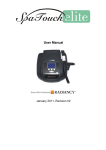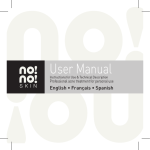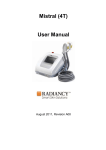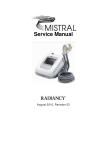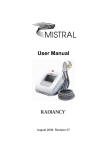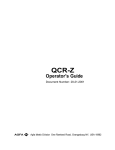Download Radiancy FSD+ User manual
Transcript
Facial SkinCare Device User Manual © 2007-2013 Radiancy Inc. All right reserved. FSD Plus (Facial Skincare Device) User Manual, March 2013. Part Number LIT-00103, Revision A00. Note: The information in this document is confidential and proprietary. It is provided to customers and authorized representatives of Radiancy only. The content of this manual is furnished for informational use only, is subject to change without notice and should not be construed as a commitment by Radiancy Inc. LHE® and Radiancy are registered trademarks of Radiancy Inc. in the United States and/or in other countries. The Quality Management System of Radiancy Ltd. complies with the Quality Management Standard ISO 13485-2012. Manufacturer: Radiancy Israel Ltd., 5 Hanagar Street, 45240 Hod Hasharon, Israel Tel: 972-9-775-7500, Fax: 972-9-775-7511 www.radiancy.com Authorized European Representative: Obelis S.A, Av. de Tervuren 34 Bte .44, B-1040 Brussels, Belgium. Tel: 32 (0) 2 732 5954, Fax: 32 (0) 2 732 6003, GSM 07545 4660, e-mail: [email protected] Contact Information Customer satisfaction is a Radiancy priority. To help us in providing you with the best possible product and support, please send us your comments and suggestions. Contact us at the addresses and telephone numbers below: US Radiancy Inc. 40 Ramland Road South, Suite 200 Orangeburg, NY 10962 USA Toll Free: 888 661-2220 Tel: +1 845 398-1647 Fax: +1 845 398-1648 E-mail: [email protected] Israel Radiancy Israel Ltd. 5 Hanagar Street 45240 Hod Hasharon Israel Tel: + 972-9-775-7500 Fax: + 972-9-775-7511 E-mail: [email protected] Before using Radiancy FSD Plus for the first time, we strongly recommend reading through the user manual in its entirety. Pay particular attention to the sections: Treatment Protocols, Operating Procedures and Post Treatment Protocols. Table of Contents Introduction to FSD Plus ���������������������������������������������������������������������������������������������� 4 Safety Instructions ������������������������������������������������������������������������������������������������������� 5 Device Description ������������������������������������������������������������������������������������������������������� 8 Know Before You Start����������������������������������������������������������������������������������������������� 11 Operating Instructions ����������������������������������������������������������������������������������������������� 14 Maintenance�������������������������������������������������������������������������������������������������������������� 18 Troubleshooting �������������������������������������������������������������������������������������������������������� 20 Standards, Safety and Specifications�������������������������������������������������������������������������� 21 Service Information����������������������������������������������������������������������������������������������������� 30 Warranty �������������������������������������������������������������������������������������������������������������������� 30 1. Introduction to FSD Plus FSD Plus represents a breakthrough in the skin care cosmetic market. With LHE® MicroPhototherapy at its core, FSD Plus can be used either for stand-alone treatments or as a part of a more comprehensive skin care program. FSD Plus is based on Radiancy’s patented LHE® Technology. LHE® has been a mainstay in the professional Phototherapy field since 2001 and has a solid reputation of safety and reliability. 4 2. Safety Instructions As with any electrical device, certain precautions must be taken in order to ensure your safety. READ ALL INSTRUCTIONS BEFORE USE. ALL WARNINGS AND CAUTIONS SHOULD BE STRICTLY FOLLOWED. WARNINGS - To reduce the risk of injury 1. Use this device only for its intended use as described in this manual. 2. Always check the Light Unit Assembly (LUA) for brown or darkened spots in the area inside the LUA lamp opening before use. If any spots appear, do not use the LUA lamp and return it for replacement. 3. This device should never be left unattended when plugged into an outlet. 4. Never operate this device if it has a damaged cord or plug, if it is not working properly, if it has been damaged or dropped into water. In any of these cases, return the device to a service center for examination or repair. 5. Do not attempt to open the handpiece or base of this device. 6. Do not attempt to touch the hot area within the Light Unit Assembly (LUA). 7. Do not use an extension cord with this device. This device should be used only with the supplied AC cord. 8. Do not reach for an appliance that has fallen into water. Unplug immediately. 9. Do not place or store this device where it can fall or be pulled into a tub or sink. 10.Do not place in or drop into water or other liquid. 11.Always unplug this device from the electrical outlet immediately after using. 12.Unplug this device before cleaning. 5 Cautions 1. Do not apply to tanned skin. 2. Cover birthmarks prior to treatment. 3. Never look directly at the light coming from the handpiece as this may cause eye injury. 4. Do not use this device on the eyelids or eye socket area. 5. Always use protective eyewear. 6. Never point the handpiece so it emits a light pulse into free space. Make sure that during treatment the handpiece is pointed at the skin and in full contact with it. 7. Always remove the handpiece from the skin if it is too hot. 8. Do not use flammable liquids such as alcohol or acetone to cleanse the skin prior to treatment. 9. The use of this product may cause temporary pigmentation changes. 6 Contraindications Do not use this device if your client: 1. Is skin type 6. 2. Is pregnant or lactating. 3. Was exposed to strong sunlight or an artificial tanning machine in the past 21 days. 4. Has a tattoo or permanent makeup in the treatment area. 5. Has used medications, herbal preparations, lotions or other chemicals that cause photosensitivity within the past 6 weeks. 6. Has an abnormal skin condition due to diabetes, for example, or to other diseases. 7. Has been treated with Accutane within the past 6 months. 8. Has been on a steroid regimen (i.e., asthma) within the past 3 months. 9. Has a history of herpes outbreaks in the area of treatment, unless the user has consulted a physician and received prophylaxis treatment prior to the FSD Plus treatment. 10.Suffers from epilepsy. 11.Has an active implant, such as a pacemaker, incontinence device, insulin pump, etc. 12.Has diseases related to photosensitivity, such as porphyria, polymorphic light eruption, solar urticaria, lupus. 13.Has a history of skin cancer or areas of potential skin malignancies. 14.Has received radiotherapy or chemotherapy treatments within the past 3 months. 15.Has any other condition which in the practitioner’s opinion would make it unsafe for them to be treated. 7 3. Device Description FSD Plus is made up of three main components; the main unit, the handpiece, and the power cord. Main Unit: Pulse Counter Control Panel On/Off Switch Hand Piece 8 Control Panel: The control panel contains indicator lights for power, ready and charging. There is also a mute switch, and energy level settings for low, medium and high. Energy Levels Mute Button Ready Indicator Light Charging Indicator Light Power On Light Hand Piece: Accessories: Treatment Head Hygienic Rings Pulse Button Client Goggles Power Cord 9 Device Set Up Use of accessories and cables other than those specified, with the exception of cables sold by the manufacturer as replacement parts for internal components, may result in increased emissions or decreased immunity of the device. 1. Before you plug in the device, verify that the LUA lamp is correctly inserted into the handpiece. A spring mechanism allows the lamp to retract when pressed to the skin and it will not operate correctly if improperly placed. 2. Attach the power cordto the back of the device. 3. Plug the cord into an electrical outlet. You are now ready to start. 10 4. Know Before You Start The Counter FSD Plus features a pulse counter window. This will help you to better plan your treatments and advise you when to replace the LUA lamp. Treatment Pulses (Treat): This line counts the amount of pulses per treatment. Reset the treatment counter by turning the unit off between clients. Unit Pulses (Total): This line counts the amount of pulses performed overall by your FSD Plus unit. When the number approaches 100,000, it is time to replace the LUA lamp. The unit pulse counter will not reset. Client Records Keeping records is very important for client satisfaction. We recommend tracking: •The energy level used during the last procedure. •The number of passes. •The number of pulses per treatment. •The number of procedures performed. •Miscellaneous information such as the reaction to treatment. •Your client’s response to the treatment. Another important factor in ensuring optimal satisfaction is the use of a photographic diary. Since some changes are subtle and occur over time, it is important to have a photographic diary that will graphically document the improvement for all your clients. 11 General Guidelines FSD Plus can be used as a stand alone treatment, or may be combined with other skin care routines. While you should rely on your experience and expertise in this area, we recommend the following treatment regimen as to the best way to incorporate FSD Plus into a comprehensive skin care program. 1. Cleanse 2. Dry 3. 2 passes with FSD Plus 4. Cool hydrating mask 5. Massage (non-oily lotion) 6. Apply toners 7. Apply moisturizers (non-stringent, non-alcoholic) 8. Apply moisturizing sun screen (SPF 30 or higher) Understanding Energy Levels and Pulsing Sequences Note: Energy levels should always be set according to your client’s comfort level. Since at first FSD Plus may feel uncomfortably hot on the skin, it is very important to be cautious and continually test your client’s skin temperature and comfort level. •There are three energy level options; low, medium and high. Each energy level setting represents the number of pulses being delivered during the pulse sequence. The more pulses delivered during the sequence, the higher the total level of energy ultimately delivered to the procedure area. It is therefore important to deliver the maximum total light energy possible without causing excessive redness or pain. •It is also important to know that the more light energy delivered to the skin, the better the effectiveness of the procedure. 12 •Differences in skin type, biology and comfort levels usually dictate that you must initially treat at the lower energy level settings. After the first 1-2 treatment sessions, however, the skin generally becomes less sensitive, which will allow you to gradually increase the energy level during subsequent uses. •Note: The goal is to deliver the highest number of pulses for maximum efficacy. It is recommended to use the highest setting possible, according to your client’s comfort, even if this means you will need to remove the handpiece due to discomfort before the sequence is completed. Whatever level you treat at, your client’s comfort level should be the guide to the energy level setting. Important Notes: •skin types 4 & 5 should only be treated with the low energy setting. •Never treat skin type 6 with FSD Plus. Use the Fitzpatrick Skin Type Classification below to determine skin type: Fitzpatrick Skin Type Classification 1 2 Always burns, never Always burns, less tans than average tan 3 Always burns, average tan 4 Rarely burns, tans easily 5 Moderately pigmented, always tans 6 Deeply pigmented, never tans Note: Darker skin may be more sensitive to the energy emitted from the lamp and may therefore require a lower energy level setting. 13 Scheduling For optimal results, FSD Plus treatments should be performed twice a week for 4 to 5 weeks. Maintenance treatments can be performed once a month or as needed. 5. Operating Instructions Test Always test your client’s reaction to FSD Plus before beginning the actual treatment. Deliver 1-3 pulses in discreet areas and wait at least 24 hours (up to 48 hours for skin types 4-5) for any possible negative reactions. Use the settings below for the initial test. 14 Skin Type Energy Level 1-3 4-5 Low-Medium Low Treatment 1. Thoroughly cleanse and dry the skin. 2. Apply a hygienic ring to the treatment head. You may reuse a hygienic ring for each client. Use a different hygienic ring for each client. 3. Press the power switch found on the top of the device. When the Ready indicator lights up, start treatment. 4. Using light pressure, place the handpiece on the skin. Make sure to stretch the skin where you apply the handpiece. Once the handpiece opening is placed correctly, an audio signal will sound. Always make sure the lamp opening is in full contact with the skin before pushing the pulse switch. 15 5. Press and hold the pulse switch to trigger a sequence of therapeutic light pulses. This sequence takes a few seconds, depending on the energy level setting (see specifications). If during the pulse sequence the Light Unit Assembly feels too hot on the skin, remove it immediately and wait until the ready indicator lights up again. 6. After emitting a pulse sequence, remove the handpiece from the skin for about 10 seconds to allow the Light Unit Assembly to cool down. Apply the next sequence only when the Ready indicator lights up. Placing the handpiece on the skin before the Ready indicator lights up may result in unwanted side effects due to pre-heating of the skin. 7. Sequentially administer pulses on the treatment area from right to left, in a horizontal pattern, with no overlap. Stacking and/or overlapping may cause crusting or blisters which could result in transient pigmentation changes. 16 8. After covering the entire area, wait one to two minutes to allow the skin to cool down then repeat the procedure making sure to begin at the initial starting point with the handpiece held vertically. 9 . When treatment is complete, turn the device off by pressing the power switch. Notes: •Wait 5 minutes between two consecutive uses. •Stop use if you see full redness of the skin, blistering or burns. •Apply pulses with no more than a 20% overlap. 17 Post Treatment •Avoid sun exposure or protect skin with sunscreen throughout the treatment process and for at least for 3 weeks following the last use. •Use a moisturizing sunscreen (SPF 30 or higher) for at least 3 weeks after treatment. •Some device users may experience hyperpigmentation resulting from the treatment. These effects, when they occur, are generally mild and transient and may be treated with a bleaching agent. Stay out of the sun until the hyperpigmentation condition resolves. 6. Maintenance Cleaning •Always unplug the device prior to cleaning it. •Use only a specially formulated cleaner for electronic equipment. •Never immerse the unit or any of its parts in water. LUA Replacement The LUA has a life of 100,000 pulses, enough for more than 200 full facials. Although the lamp may continue to flash after that, the pulses will be weak and ineffectual. To ensure effectiveness always replace the LUA when the total line on the pulse counter reaches 100,000 or an equivalent thereof. 18 To insert or replace the LUA: Picture A Picture B 1. Turn the device off and unplug the cord from the electrical outlet. 2. Grasp the LUA by both ends and pull it out of the socket (Picture A). 3. Line up the holes in the socket with the metal and plastic posts in the LUA and push it gently into place (Picture B). 4. If correctly installed, the LUA will spring back when pushed in and released. Fuse Replacement Should the device turn off unexpectedly or fail to operate when you have plugged it in and pushed the on/off switch, it is possible that you may have a blown fuse. To check this: 1. Turn the device off and unplug the cord from the wall electrical outlet. 2. Pull out the fuse drawer located at the rear part of the base. Remove the inner fuse. Check the filament if it is severed the fuse needs to be replaced. 3. Replace the fuse with the spare (located in the outer bay of the fuse drawer) and push the drawer back into place. 19 7. Troubleshooting If the device does not start: •Make sure that the power cord is connected into the wall electrical outlet. •Check the fuse inside the fuse drawer. Replace fuse if blown (see instructions on Fuse Replacment section). •If a pulse sequence is not released when pressing the Pulse Switch: •Gently press the Handpiece opening onto the skin and listen for the audio signal. If there is no audio signal, contact FSD Plus service center. •The device might be overheated. Turn off the device for 30 minutes to allow it to cool down. •If the pulse rate within a sequence slows down or if the charging and ready indicators turn on and off repeatedly, the device may be overheated. Turn off the device for 30 minutes to allow it to cool down. •If at any point the device goes into charging mode for longer periods, this is due to an internal safety mechanism that monitors the LUA temperature and is designed to avoid over-heating. Wait until the ready indicator light turns on again, and only then replace the handpiece on the skin. •If any problem persists, contact FSD Plus service through Radiancy or your point of purchase. Radiancy is responsible for the effects on safety, reliability and performance of the equipment only if repairs are carried out by Radiancy authorized personnel. 20 8. Standards, Safety and Specifications Design and technical specifications are subject to change without notice. International Standards FSD Plus complies with the following international standards and directives: Electrical Safety Medical Electrical Equipment – Part 1: General Requirements for Basic Safety and Essential Performance, 3rd Ed: IEC60601-1:2005/ EN60601-1:2006 Electromagnetic Compatibility IEC 60601-1-2:2007 EU Directive: Low Voltage Directive 2006/95/EC Electromagnetic Compatibility Directive 2004/108/EC The CE mark represents the compliance to the European Low Voltage Directive 2006/95/EC and the Electromagnetic Compatibility Directive 2004/108/EC. 21 Declaration of Electromagnetic Compatibility (EMC) FSD requires special precautions regarding EMC and needs to be installed and put into service according to the EMC information provided in the accompanying documents. FSD complies with international standards for: Electromagnetic Emissions Levels. FSD is intended for use in the electromagnetic environment specified below. The customer/user of FSD should assure that it is used in such an environment. Emissions Test Compliance Electromagnetic Environment - Guidance RF emissions CISPR 11 Group 1 FSD uses RF energy only for its internal function. Therefore, its RF emissions are very low and are not likely to cause any interference in nearby electronic equipment. RF emissions CISPR 11 Class B Harmonic emissions IEC 61000-3-2 Class A FSD is suitable for use in all establishments, including domestic establishments and those directly connected to the public low-voltage power supply network that supplies buildings used for domestic purposes. Voltage fluctuations/ flicker emissions IEC 61000-3-3 Complies Table 1: Electromagnetic Emissions Levels Compliance 22 FSD complies with international standards for: Electromagnetic Immunity Levels (1). FSD is intended for use in the electromagnetic environment specified below; The customer or the user of FSD should assure that it is used in such an environment. Immunity test IEC 60601-1-2 Test level Electrostatic discharge (ESD) IEC 61000-4-2 6 kV contact 8 kV air Compliance level 6 kV contact 8 kV air Electromagnetic Environment Guidancew Floors should be wood, concrete or ceramic tile. If floors are covered with synthetic material, the relative humidity should be at least 30%. Electrical fast transient/burst IEC 61000-4-4 2 kV for power 2 kV for power supply lines supply lines 1 kV for input/output Not Applicable lines Mains power quality should be that of a typical public low-voltage power supply network that supplies buildings used for domestic purposes, commercial or hospital environment. Surge IEC 61000-4-5 1 kV differential 1 kV differential mode mode 2 kV common mode 2 kV common mode Mains power quality should be that of a typical public low-voltage power supply network that supplies buildings used for domestic purposes, commercial or hospital Environment. Voltage dips, short interruptions and voltage variations on power supply input lines <5 %UT (>95 %dip in UT) for 0,5 cycle 40 %UT (60 %dip in UT) for 5 cycles <5 %UT 70 %UT (30 %dip in UT) for 25 cycles <5 %UT <5 %UT (>95 %dip in UT) for 5s <5 %UT (>95 %dip in UT) for 0,5 cycle 40 %UT (60 %dip in UT) for 5 cycles <5 %UT 70 %UT (30 %dip in UT) for 25 cycles <5 %UT <5 %UT (>95 %dip in UT) for 5s Mains power quality should be that of a typical public low-voltage power supply network that supplies buildings used for domestic purposes, commercial or hospital Environment. If the user of the FSD requires continued operation during power mains interruptions; it is recommended that FSD be powered from an uninterruptible power Supply or a battery. 3 A/m 3 A/m Power frequency magnetic fields should be at levels characteristic of a typical public low-voltage power supply network that supplies buildings used for domestic purposes, commercial or hospital environment. IEC 61000-4-11 Power frequency (50/60 Hz) magnetic field IEC 61000-4-8 NOTE: UT is the A.C. mains voltage prior to application of the test level. Table 2: Electromagnetic Immunity Compliance (1) 23 FSD complies with international standards for: Electromagnetic Immunity Levels (2). FSD is intended for use in the electromagnetic environment specified below. The customer or the user of the FSD should assure that it is used in such an environment. Immunity test IEC 60601-1-2 Test level Compliance level Electromagnetic Environment - Guidance Conducted RF IEC 61000-4-6 3 Vrms 150 k Hz to 80 MHz 3 Vrms Radiated RF IEC 61000-4-3 3 V/m 80 MHz to 2,5 GHz 3 V/m Portable and mobile RF communications equipment should be used no closer to any part of the FSD, including cables, than the recommended separation distance calculated from the equation applicable to the frequency of the transmitter. Recommended separation distance d = 1.17√P d = 1.17√P 80 M Hz t o 800 MHz d= 2.34√P 800 MHz t o 2,5 GHz Where P is the maximum output power rating of the transmitter in watts (W) according to the transmitter manufacturer and d is the recommended separation distance in meters (m). Field strengths from fixed R F transmitters, as determined by an electromagnetic site surveya should be less than the compliance level in each frequency ranged. Interference may occur in the vicinity of equipment marked with the following symbol: NOTE 1 – At 80 MHz and 800 MHz, the higher frequency range applies. NOTE 2 – These guidelines may not apply in all situations .Electromagnetic propagation is affected by absorption and reflection from structures objects and people. a. Field strengths from fixed transmitters, such as base stations for radio (cellular/cordless) telephones and land mobile radios, amateur radio, AM and FM radio broadcast and TV broadcast cannot be predicted theoretically with accuracy. To assess the electromagnetic environment due to fixed RF transmitters, an electromagnetic site survey should be considered. If the measured field strength in the location in which the FSD is used exceeds the applicable RF compliance level above, the FSD should be observed to verify normal operation. If abnormal performance is observed, additional measures may be necessary, such as re-orienting or relocating the FSD. b. Over the frequency range 150 kHz to 80 MHz, field strengths should be less than 3 V/m. 24 Table 3: Electromagnetic Immunity Compliance (2) Recommended separation distances between: Portable and Mobile RF Communications Equipment and FSD FSD is intended for use in an electromagnetic environment in which radiated RF disturbances are controlled. The customer or the user of t FSD can help prevent electromagnetic interference by maintaining a minimum distance between port able and m obi le RF communications equipment (transmitters)and the FSD as recommended below, according to the maximum out put power of t he communications equipment. Rated maximum output power of transmitter Watts [W] distance according to frequency of transmitter meters [m] 150kHz to 80MHz d = 1.17√P 80MHz to 800MHz d = 1.17√P 800MHz to 2.5GHz d= 2.34√P 0.12 0.12 0.24 0.37 0.37 0.74 1.17 1.17 2.34 3.7 3.7 7.4 11.7 11.7 23.4 For transmitters rated at a maximum output power not listed above, the recommended separation distance d in meters (m) can be estimated using the equation applicable to the frequency of the transmitter, where P is the maximum output power rating of the transmitter in watts (W) according to the transmitter manufacturer. NOTE 1 At 80 MHz and 800 MHz, the separation distance for the higher frequency range applies. NOTE 2 These guidelines may not apply in all situations. Electromagnetic propagation is affected by absorption and reflection from structures, objects, and people. Table 4: Separation Distances 25 Electrical Safety Degree of protection against ingress water: ordinary. This device is not suitable for use in the presence of flammable anesthetic mixture with air or with Oxygen or Nitrous Oxide. Technical Specifications Light Source: Pulsed light Technology: LHE® (Light and Heat Energy) Pulse duration: 1.6 msec Energy: 1.2 J/cm2 per pulse in a train of 5, 8, 10 pulses Fluence: High 12 J/cm2 in one working cycle (6.7Sec.) Medium 9.6 J/cm2 in one working cycle (5.3 Sec.) Low 6 J/cm2 in one working cycle (3.3 Sec.) Spot size: 14 x 27 mm Wavelength: 400-1200 nm Weight: 1.3kg (2.8lbs) Physical Dimensions: 29.5cm X 21cm X 5.5cm (w/d/h) Mode of Operation: Rating: 26 (11.6” x 8.3” x 2.2” ) (w/d/h) Continuous 100/110VAC ±10% 25A 50-60 Hz 230VAC ±10% 16A 50-60 Hz Operation Conditions Temperature Humidity 30ºC 5ºC 80%RH 30%RH Transport & Storage Temperature Humidity 80ºC -20ºC 95%RH 0%RH 1.5 atm Atmospheric Pressure 0.1 atm 27 Labels This section describes the labels affixed to the FSD Plus. It is recommended that users review the meaning of these labels for everyday usage and in case any details are needed for service. The table below briefly reviews a number of internationally recognized symbols that are found on the FSD Plus main unit and its external package. Symbol Meaning Attention Consult accompanying documents Degree of protection against electric shock: Type BF applied part 100-115VAC Voltage sticker appearing on outer package On/Off sign Class II equipment – double insulation Indicates the temperature limits to which the medical device can be safely exposed. Indicates the range of humidity to which the medical device can be safely exposed. Indicates the range of atmospheric pressure limits to which the medical device can be safely exposed. IP22 28 IP22 according to IEC60529, Degrees of Protection Provided by Enclosures (IP Code). In addition, these stickers are found on the main unit and LUA’s. These include serial numbers of the system parts and some usage warnings. Label Location Located at the bottom of the system, this label includes manufacturer’s details, voltage information and the system’s serial number. Located on the rear pane, above the power inlet. This warning appears next to the opening on all LUAs Serial number found on LUA 29 9. Service Information In case you need service, contact Radiancy. Do not attempt to service the unit yourself. This will void your warranty. Radiancy Inc. Radiancy Israel Ltd. 40 Ramland Road South, Suite 10 Orangeburg, NY 10962, USA Toll Free Number: 888-661-2220 5 Hanagar Street 45240 Hod Hasharon Israel Tel: 1-845-398-1647 Tel: + 972-9-775-7500 Fax: 1-845-398-1648 Fax: + 972-9-775-7511 [email protected] E-mail: [email protected] 10. Warranty After receiving FSD Plus and operating it for the first time, please fill out this warranty card, photocopy and send to: Radiancy Israel Ltd. 5 Hanagar Street 45240 Hod Hasharon Israel POB 7329 Fax: + 972-9-775-7511 30 FSD Plus - Facial SkinCare Device Warranty Card: User Information: System Details: Name: Serial Number: Street: Purchase Date: City: Comments: State/Province: Country: Zip Code: Tel: Fax: Mobile: E-mail: Was the system received without visible external damage? Yes No. Please describe: Did the system operate properly immediately after installation? Yes No. Please describe: 31 LIT-00103/ Rev.A00/ March.2013 Smart Skin Solutions

































